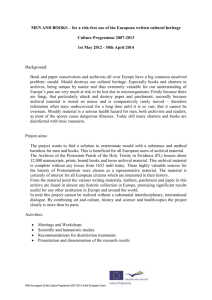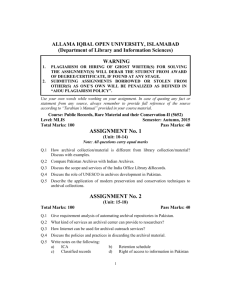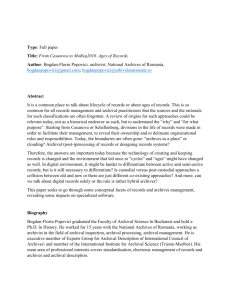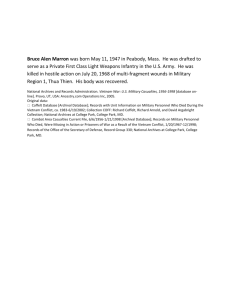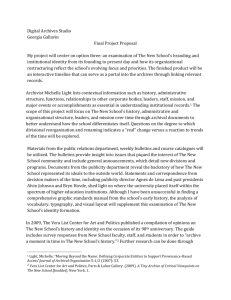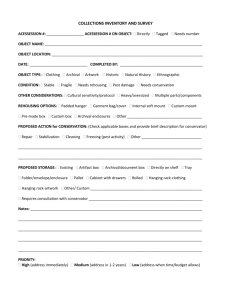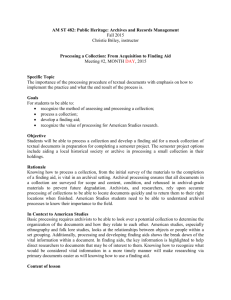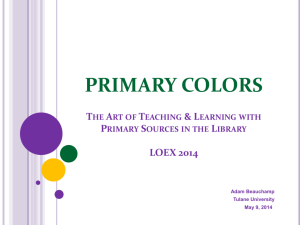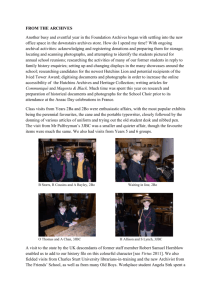Archival Research Glossary and Exercise
advertisement
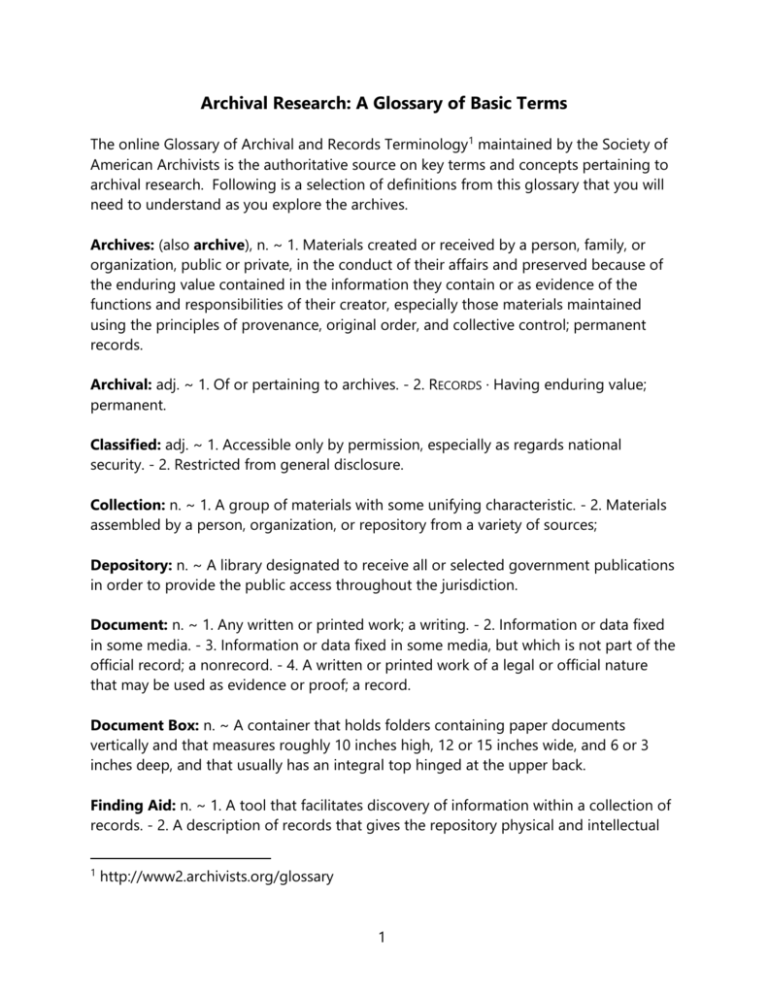
Archival Research: A Glossary of Basic Terms The online Glossary of Archival and Records Terminology1 maintained by the Society of American Archivists is the authoritative source on key terms and concepts pertaining to archival research. Following is a selection of definitions from this glossary that you will need to understand as you explore the archives. Archives: (also archive), n. ~ 1. Materials created or received by a person, family, or organization, public or private, in the conduct of their affairs and preserved because of the enduring value contained in the information they contain or as evidence of the functions and responsibilities of their creator, especially those materials maintained using the principles of provenance, original order, and collective control; permanent records. Archival: adj. ~ 1. Of or pertaining to archives. - 2. RECORDS · Having enduring value; permanent. Classified: adj. ~ 1. Accessible only by permission, especially as regards national security. - 2. Restricted from general disclosure. Collection: n. ~ 1. A group of materials with some unifying characteristic. - 2. Materials assembled by a person, organization, or repository from a variety of sources; Depository: n. ~ A library designated to receive all or selected government publications in order to provide the public access throughout the jurisdiction. Document: n. ~ 1. Any written or printed work; a writing. - 2. Information or data fixed in some media. - 3. Information or data fixed in some media, but which is not part of the official record; a nonrecord. - 4. A written or printed work of a legal or official nature that may be used as evidence or proof; a record. Document Box: n. ~ A container that holds folders containing paper documents vertically and that measures roughly 10 inches high, 12 or 15 inches wide, and 6 or 3 inches deep, and that usually has an integral top hinged at the upper back. Finding Aid: n. ~ 1. A tool that facilitates discovery of information within a collection of records. - 2. A description of records that gives the repository physical and intellectual 1 http://www2.archivists.org/glossary 1 control over the materials and that assists users to gain access to and understand the materials. Folder: n. ~ 1. A sheet of cardboard or heavy paper stock that is used as a loose cover to keep documents and other flat materials together, especially for purposes of filing Library: n. ~ 1. A collection of published materials, including books, magazines, sound and video recordings, and other formats. - 2. A building used to house such a collection. Manuscript: n. (ms, abbr.) ~ 1. A handwritten document. - 2. An unpublished document. - 3. An author's draft of a book, article, or other work submitted for publication. Papers: n. ~ 1. A collection. - 2. A collection of personal or family documents; personal papers. Primary Source: n. ~ Material that contains firsthand accounts of events and that was created contemporaneous to those events or later recalled by an eyewitness. Notes: Primary sources emphasize the lack of intermediaries between the thing or events being studied and reports of those things or events based on the belief that firsthand accounts are more accurate. Examples of primary sources include letters and diaries; government, church, and business records; oral histories; photographs, motion pictures, and videos; maps and land records; and blueprints. Newspaper articles contemporaneous with the events described are traditionally considered primary sources, although the reporter may have compiled the story from witnesses, rather than being an eyewitness. Artifacts and specimens may also be primary evidence if they are the object of study. Rare Books and Manuscripts Section: n. (RBMS, abbr.) ~ A professional organization that promotes the interests of librarians, curators, and other specialists concerned with the acquisition, organization, security, preservation, administration, and use of special collections, including rare printed books, manuscripts, archives, graphics, music, and ephemera. Record: n. ~ 1. A written or printed work of a legal or official nature that may be used as evidence or proof; a document. Redaction: n. ~ 1. The process of concealing sensitive information in a document before being released to someone not authorized to see that information. 2 Researcher: n. ~ An individual who uses the collections and services of a repository; a customer; a patron; a reader. Secondary Source: n. ~ 1. A work that is not based on direct observation of or evidence directly associated with the subject, but instead relies on sources of information. - 2. A work commenting on another work (primary sources), such as reviews, criticism, and commentaries. Archival Research Terms: An Exercise Using the “Archival Research: A Glossary of Basic Terms” handout, answer the following questions. 1) What is the difference between a primary source and a secondary source? List a few examples of each. _____________________________________________________________________________________________ _____________________________________________________________________________________________ ________________________ 2) What is the difference between an archive and a library? _____________________________________________________________________________________________ _____________________________________________________________________________________________ ________________________ 3) If you are interested in exploring the content of an archival collection, what tool might you use to discover what is available in the collection? 3 ______________________________________________________________________ 4) What will you find inside a document box? ______________________________________________________________________ 5) A document, a manuscript, a record, and papers are all items you might find in an archival collection. Compare and contrast these terms as they are defined in the handout. ______________________________________________________________________________ ______________________________________________________________________________ ______________________________________________________________________________ ______________________________________________________________________________ ______________________________________________________________________________ 6) If a document you find in an archival collection was formerly classified, part of its content might have been concealed by government authorities. What is the term for the process of concealing sensitive information in a document? ______________________________________________________________________ 4

